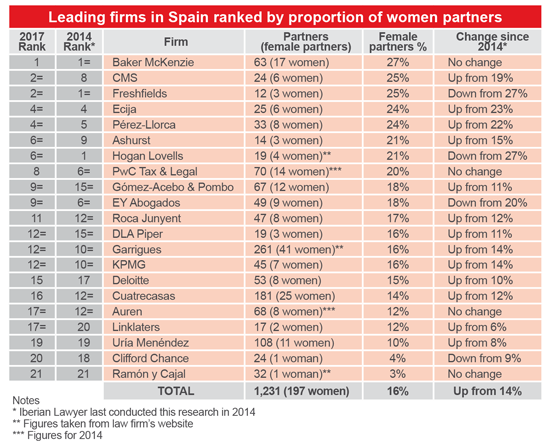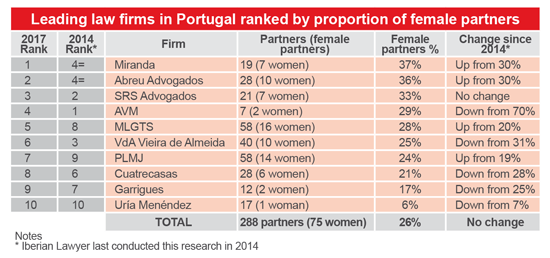Still in the shadows

 Although the proportion of women partners at law firms in Iberia is on the rise, only one in six partners in Spain, for example, is a woman – given that most law graduates are women, firms clearly need to do more to ensure they stop losing so many female lawyers before they reach the partnership
Although the proportion of women partners at law firms in Iberia is on the rise, only one in six partners in Spain, for example, is a woman – given that most law graduates are women, firms clearly need to do more to ensure they stop losing so many female lawyers before they reach the partnership
The proportion of women partners at law firms in Spain has increased slightly in the last three years, according to new data compiled by Iberian Lawyer. However, despite the rise, only one in six partners at the biggest law firms in Spain is a woman. This is significant because there is a drive to increase the number of women partners at many law firms – indeed, some firms have set female partner targets of up to 40 per cent.
However, women continue to be better represented at partnership level in law firms in Portugal. The latest study showed 26 per cent of partners at Portuguese firms are women. That said, female participation at law firms in Portugal has not increased in the last three years – the figure for the 2014 study was also 26 per cent. The latest research updated the data for firms covered in the 2014 research, which were the 21 biggest firms in Spain by revenue and the ten biggest law firms in Portugal by headcount.
Intriguingly, while some of the firms with the biggest proportion of female partners have targets for female participation, others do not. Meanwhile, there are other firms with very small numbers of women partners despite the fact that they do have targets for enhancing the role of women within their organisation – the fact such firms have these targets could be a result of the fact they have acknowledged they have a problem in this area.
The firm topping the charts in Spain with the biggest proportion of women partners is Baker McKenzie – 17 of the firm’s 63 partners in Spain are women, which equates to 27 per cent. Given the firm is a leader in this area, how has it gone about it? Since 2012, the firm has a “gender policy”, which is specifically designed to encourage the recruitment and retention of women lawyers, as well as developing their career opportunities by “developing firm-wide initiatives to support women into assuming leadership roles,” the firm says. One such initiative is ‘BakerWoman’, a platform for sharing information, learning resources and policies to aid female career development.  Baker McKenzie has also set targets for increasing female participation in the firm – these include aiming to ensure women make up “40 per cent of local partners, 30 per cent of principals and 30 per cent of firm leadership positions”. Meanwhile, Baker McKenzie also has ‘Gender Diversity Champions’ in each region – in the Madrid office, this role is filled by partner Maite Diez, who served as Baker McKenzie’s Spain managing partner from 2002 to 2008.
Baker McKenzie has also set targets for increasing female participation in the firm – these include aiming to ensure women make up “40 per cent of local partners, 30 per cent of principals and 30 per cent of firm leadership positions”. Meanwhile, Baker McKenzie also has ‘Gender Diversity Champions’ in each region – in the Madrid office, this role is filled by partner Maite Diez, who served as Baker McKenzie’s Spain managing partner from 2002 to 2008.
Similarly, Cuatrecasas has set targets for the level of female involvement in the firm. In 2014, the firm entered into two agreements with the Spanish Minister for Health, Social Services and Equality aimed at creating an “equal opportunity environment” – as part of the agreements, the firm committed to increase the number of women in management positions to at least 25 per cent by 2020. Meanwhile, the firm also pledged to increase female participation at board level to 25 per cent by 2020, and 33 per cent by 2024.
In terms of whether Cuatrecasas is making progress with regard to increasing its number of women partners, there is a mixed picture. While the proportion of female partners at the firm in Spain has increased from 12 per cent to 14 per cent in the last three years, the percentage of women partners at Cuatrecasas’ in Portugal has dropped in the same period, falling from 28 per cent to 21 per cent. However, the firm’s managing partner in Portugal is a woman, Maria João Ricou.
Linklaters is another firm that has set female participation targets, though it is one of the major firms with the lowest proportions of female partners in Spain – that said, the percentage of partners in its Madrid office increased from 6 per cent to 12 per cent in the last three years. Its targets include “attaining above 30 per cent for female elections to the partnership” as well as committing to doubling the proportion of women sitting on the firm’s “top-two management committees” from 15 per cent to 30 per cent by 2018.
Linklaters says it is committed to ensuring that it has a greater proportion of women at senior levels to act as role models and mentors. A Linklaters spokesman says: “The firm is taking a holistic approach to female development by offering specific coaching, mentoring, structured learning and career development support to female talent at all stages of the pipeline – from junior associate, to senior associate and partner.” In contrast, CMS Albiñana & Suárez de Lezo has the second-highest proportion of women partners among the major firms in Spain (25 per cent), despite having no specific policy, or designated person, for increasing female participation. Another firm that has not developed a policy, or appointed person, for enhancing the role of women is Pérez-Llorca – yet the firm has a significant proportion of women lawyers compared to its rivals (24 per cent). Meanwhile, though Clifford Chance highlights that, at a global level, the percentage of women in its partnership grew from 15 per cent in 2012 to 19 per cent in 2017, it appears the firm’s Spanish office is falling behind its counterparts in other jurisdictions in this respect. Only one of the 24 partners at Clifford Chance in Spain is female.
In Portugal, the firm with the biggest proportion of women partners is Miranda – seven of the firm’s 19 partners are women, which equates to 37 per cent. The firm says “gender balance” is part of its culture and highlights that one of its founding partners is a woman, Rita Correia. It also says two-thirds (67 per cent) of the firm’s personnel are women, including fee-earners and professional services staff. “This may seem fairly normal in the current context where more women than men are graduating from law schools,” says partner Ana Pinelas Pinto. “What may not be so common is to have such a strong representation in the partnership and on the board of directors (three of the seven directors are women).” However, Pinelas Pinto says that the firm has never felt the need to have a designated person, or persons, responsible for enhancing the role of women.
Numbers speak for themselves
SRS Advogados is among the firms with the largest proportion of women partners (33 per cent), but, like Miranda, the firm does not have a designated person for enhancing female participation: “Given that 60 per cent of the firm [including all roles] are women, we feel that it is not necessary – the numbers speak for themselves.” Meanwhile, at VDA Vieira de Almeida – where one in four partners is a woman – initiatives include up to 150 days paid maternity leave as well as an ‘unbundling career plan’ that enables female lawyers to accompany “their husbands working or studying abroad with a reduction of their billable hours objectives and a different career as a consultant”. Elsewhere, Abreu Advogados, a firm that recently appointed a female chairwoman, Carmo Sousa Machado (who has previously served as the firm’s managing partner), is another firm with a higher proportion of women partners than most (36 per cent) – this is despite the fact that, though the firm says it “promotes gender equality”, it does not have a formal policy, or designated person, in place to address the issue.
The data shows that in Spain in particular, but also in Portugal, progress on getting more women into law firm partnerships is slow. But managing partners ignore this issue at their peril. As highlighted in our Madrid Annual Report (page 26), law firms are not as diverse in their make-up as their clients, and one of the most crucial tasks they face now is ensuring they better reflect the clients they serve. In addition, with female law graduates currently outnumbering their male counterparts, law firms need to work out why they are losing so many talented lawyers on the path to partnership. Cuatrecasas’ Madrid managing partner Fernando Bernad says law firms have to make younger lawyers, in general, a “more attractive offer”. He adds that the major talent retention issue firms now face is “being able to better integrate women into the partnership so that it reflects the percentage of women lawyers they currently hire”.











